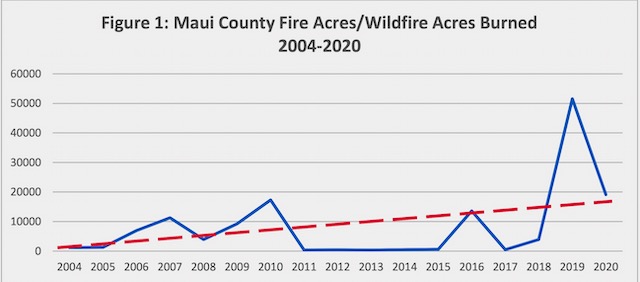Opposition To Government Regulatory Mandates And Funding Contributed to Hawaii Wildfire Disaster
Neoliberal Anti-Government Austerians Strike Again
The following is based on official reports by the Hawaiian government. Links and excerpts provided below.
Hawaiian and federal government officials were fully aware of wildfire risks and the fact that current wildfire prevention and response programs were totally inadequate to protect public safety from increasingly frequent and severe wildfires.
Those same officials were fully aware of the science and management approach required to prevent wildfires and reduce wildfire risks, see:
Simultaneously, fires on the islands of nearby Maui and Oʻahu burned 1,043 ha (2,577 ac) and 162 ha (400 ac), respectively. Land-use characteristics and antecedent moisture conditions exacerbated fire hazard, and both fire and rain severity were influenced by the storm environment and local topographical features. … The compounding nature of the hazards produced during the Hurricane Lane event highlights the need to improve anticipation of complex feedback mechanisms among climate- and weather-related phenomena.
Officials consciously chose not to act due to political opposition to government regulatory mandates and funding.
Of course, you will not read much about these underlying and deeply negligent causes in corporate media.
[Update: The NY Times reporting even diverts to other issues.]
Specifically, see this July 2021 Report:
This Report explicitly rejected new regulations and new revenues, despite increasing wildfire threats:
The investigation found that the number of incidents from a combination of wild/brush/forest fires appears to be increasing, and that this increase poses an increased threat to citizens, properties, and sacred sites. It was assumed at the start of the inquiry that an increase in fire events would subsequently increase firefighting cost overruns, response problems, and result in budgetary pressures for additional fire prevention and fire response resources. This assumption was not supported by the research. It was also assumed that new regulations would likely be needed to meet wildfire threats. This assumption was also not supported.
The investigation revealed that current budgets, combined with County and State access to Federal emergency relief funding, are adequate to meet the current fire threat, but are inadequate for an effective fire prevention and mitigation program. Additional policies and statutes that impose punitive fines, financial recovery, or additional preventative actions are not recommended. The Commission finds that punitive measures are not particularly effective, and that existing preventative and enforcement practices of the Maui County Fire Chief can be expanded to achieve needed wildfire prevention and safety measures pursuant to State law.
Let’s repeat that astonishingly irresponsible recommendation:
Additional policies and statutes that impose punitive fines, financial recovery, or additional preventative actions are not recommended.
This insanely irresponsible recommendation directly contradicted a major finding of the Report that prevention efforts were ignored, a “significant oversight” (see page 10):
However, in the Department’s recently released strategic plan for 2021–2025, prevention is given short shrift.There is no stated goal of fire prevention, or any metric to assess success or improvement in prevention. There is much space devoted to preventing injuries and illness in employees, and to preventing equipment failure, but nothing about what can and should be done to prevent fires.20
According to University of Hawaiʻi wildland fire researcher and professor Clay Trauernicht, public education is one of two main methods to mitigate fire risk in Hawaiʻi.21 As previously asserted, any plan to reduce wild/brush/forest fires must incorporate both prevention and response. The Department’s new strategic plan fails to address fire prevention as a mission or goal, a significant oversight.
Amazingly, the Report also notes specific management recommendations from a prior scientific Report, see page 13:
The following additional recommendations are reproduced from the Hawaii Wildfire Management Organization report entitled, “Collaborative Landscape-Level Approach to Reduce Wildfire Hazard Across Hawaii: 2018-19 Vegetation Management — Rapid Mapping Assessment and Collaborative Action Planning — Maui Report.”22This report was a product of the Collaborative Action Planning Workshop, in which private companies, nonprofit organizations, landowners, and various fire research organizations identified numerous maintenance actions needed to reduce the spread of wild/brush/forest fires. The recommendations are notable and worth repeating below:
But the Report refused to support regulations and funding to implement these recommendations.
The Report merely recommended public education and additional study: (page 14, emphasis in original)
To begin the process, the Commission recommends that a thorough risk assessment of wildfire/brush/forest hazards be conducted to aid in prioritizing and sequencing the implementation of this report’s recommendations
I found very similar underlying causes in the 2017 Northern California wildfires, which also failed to warn residents, see:
And I’ve criticized the failure of NJ officials to prevent and reduce wildfire hazards by limiting new development and mandating the retrofit of existing development in high wildfire hazard areas, see:
Maybe this disaster will drive change – but I doubt it.
NJ did little after the Superstorm Sandy disaster other than “Rebuild Madness” – I sense that Rebuild Madness is coming to Hawaii.
